The Jeweled Cross Series of 1679-1699
by Philip Flemming
A puzzling start for the first gold coinage of Mexico
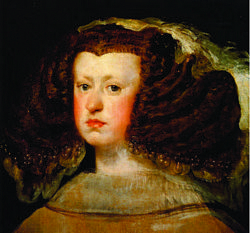 This woman did what her husband refused to do and we don’t know why. On 25 February 1675, the widow of Philip IIII, Mariana of Austria, acting as regent for the 13-year-old, disabled Carlos II, issued a cedula[text needed] granting New Spain the long-sought privilege of a gold coinage. The Mexico City mint had been in operation 140 years at that point. The Colombian mints had been striking gold for more than 50 years, but the Spanish crown had remained unwilling to license a gold coinage in the viceroyalty of New Spain. Despite the serious inconveniences to commerce this entailed, Philip IIII had continued to oppose a Mexican gold coinage even after domestic Mexican gold production had become significant from the mines at San Luis Potosí, Guanajuato, and Guadalajara.
This woman did what her husband refused to do and we don’t know why. On 25 February 1675, the widow of Philip IIII, Mariana of Austria, acting as regent for the 13-year-old, disabled Carlos II, issued a cedula[text needed] granting New Spain the long-sought privilege of a gold coinage. The Mexico City mint had been in operation 140 years at that point. The Colombian mints had been striking gold for more than 50 years, but the Spanish crown had remained unwilling to license a gold coinage in the viceroyalty of New Spain. Despite the serious inconveniences to commerce this entailed, Philip IIII had continued to oppose a Mexican gold coinage even after domestic Mexican gold production had become significant from the mines at San Luis Potosí, Guanajuato, and Guadalajara.
Pradeau in his Numismatic History of Mexico tells us that there was rejoicing in the streets of Mexico City when the queen’s order was read in May of 1675. After the celebration, things did not move forward quickly. A year passed before in May of 1676 the viceroy of Nueva España, Fray Payo Enrique de Rivera, orders the Mexico City mint to strike a gold coinage in denominations of eight, four, two and one escudos. Three and a half years after the viceroy’s order there were still no gold coins being struck. Finally, at the very end of 1679, a gold coinage is announced. On 23 December 1679 the viceroy and members of the Audiencia visit the mint to witness the first striking of a Mexican gold coinage. In the last week of December the mint strikes 63 marks of gold, equivalent to 4,284 escudos. None of this first issue apparently was saved or has survived from circulation. We are told of no special strikings presented to the viceroy or sent back to Mariana and Carlos.
Several things are puzzling in this account, but the three and half year delay in implementing the viceroy’s order stands out. Colonial mints could be slow when they were ordered to do something they didn’t want to do (like mechanize), but they also could be quick when they wanted something to happen. Mexico City was Spain’s premier colonial mint and it had been producing a substantial silver coinage for a long time. No new building was needed to accommodate the gold coinage. Few or no new staff were needed initially. If it was felt that Martin López would do a better job than Bercerra in launching the gold coinage, López (assayer L) was in place by 1677. Not much new equipment was needed. Remember it was to be a gold cob coinage, not a milled coinage. New dies and punches had to be prepared, probably in Spain, but given the viceroy’s order of May 1676 to start the coinage, there must have been reason to expect that dies would shortly be available. Several things point to 1677 as the year the gold coinage was expected to begin. So what happened? It is very hard to imagine purely technical problems delaying Mexico City, the best Spanish colonial mint, for three and half years. We need to consider other possibilities.
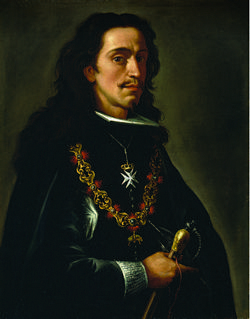 In November of 1675 Carlos’ regency officially ended, but the disabled 14-year-old king continued to cede control of the government to his mother. Mariana was opposed politically and sometimes militarily by the respected Spanish general Don Juan José de Austria, himself an illegitimate son of Philip IIII. In early 1677 Mariana lost control of the government to Don Juan José in the wake of a corruption scandal linked to one of her favorites. Mariana was exiled to Toledo, and Don Juan José took the reins of power, promising to reverse the corrupt and incompetent policies of Mariana’s regime. Among the policies that may well have fallen under immediate suspicion and been suspended was Mariana’s approval of a Mexican gold mint, especially since that approval seems to have been linked to one of Mariana’s corrupt favorites (Valenzuela). Don Juan José’s reformist regime came to a sudden and suspicious end with his death in September 1679. Mariana immediately returned to power, overturning Don Juan José’s reforms. A little over three months later the Mexican gold coinage was back on track. The circumstances of the late December mintage suggest a hasty start after an enforced delay. We can imagine a letter from Mariana arriving on a December aviso, pointedly asking the Mexican viceroy whether the coinage she had approved nearly five years ago was yet in production. If gold dies had been at the Mexico City mint since 1677 (but prohibited from use by Don Juan José), it would not have been difficult several weeks later to strike a small coinage. Even if the gold dies had been embargoed in Spain during Don Juan José’s term and just arrived on the aviso, it would have been possible to hastily press a few dies into service.
In November of 1675 Carlos’ regency officially ended, but the disabled 14-year-old king continued to cede control of the government to his mother. Mariana was opposed politically and sometimes militarily by the respected Spanish general Don Juan José de Austria, himself an illegitimate son of Philip IIII. In early 1677 Mariana lost control of the government to Don Juan José in the wake of a corruption scandal linked to one of her favorites. Mariana was exiled to Toledo, and Don Juan José took the reins of power, promising to reverse the corrupt and incompetent policies of Mariana’s regime. Among the policies that may well have fallen under immediate suspicion and been suspended was Mariana’s approval of a Mexican gold mint, especially since that approval seems to have been linked to one of Mariana’s corrupt favorites (Valenzuela). Don Juan José’s reformist regime came to a sudden and suspicious end with his death in September 1679. Mariana immediately returned to power, overturning Don Juan José’s reforms. A little over three months later the Mexican gold coinage was back on track. The circumstances of the late December mintage suggest a hasty start after an enforced delay. We can imagine a letter from Mariana arriving on a December aviso, pointedly asking the Mexican viceroy whether the coinage she had approved nearly five years ago was yet in production. If gold dies had been at the Mexico City mint since 1677 (but prohibited from use by Don Juan José), it would not have been difficult several weeks later to strike a small coinage. Even if the gold dies had been embargoed in Spain during Don Juan José’s term and just arrived on the aviso, it would have been possible to hastily press a few dies into service.
The distinctive designs of the Jeweled Cross series
No documents from the Archivo General de Indias have been found discussing how the designs for the new Mexican gold coinage were approved. The Spanish Crown was always very concerned about the designs used on the coinage of its New World mints. Pattern dies were almost always made in Spain for a new colonial coinage. We do not know for sure that the first Jeweled Cross dies were engraved in Spain, but it seems likely. What is clear from the coins themselves is that a very distinctive design was mandated. Jeweled Cross issues can be recognized at arm’s length as different from peninsular escudos. This is no accident. The problems that Philip IIII had had with Potosí and Cartagena and Lima were remembered in Spain. If anything similar should arise with the Mexican gold coinage, the Spanish Crown wanted that coinage to be immediately distinguishable from the peninsular gold issues of Barcelona or Madrid or Seville.
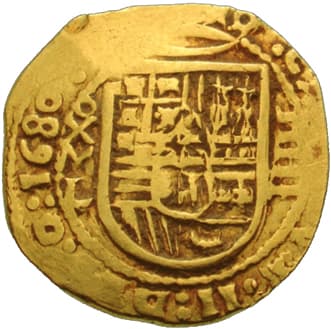
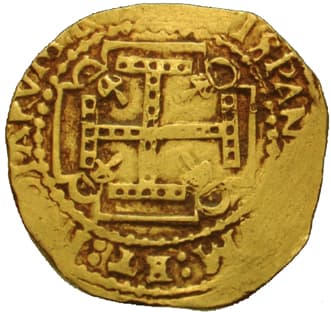
Mexico, 1680, four escudos (Tauler 79)
The Jeweled Cross designs were strikingly different. On all denominations a broad Jerusalem cross displays a series of holes on all the arms and end bars. On the onza, 33 or 35 holes are most frequent; on the media onza, 29 to 34 holes. These holes are intaglio, not raised features, so perhaps “jeweled” cross is not the most apt description. Should we call it a “holed” cross? Surrounding the Jerusalem cross is a tressure in the rectangular shape of a large cross. This rectangular shape is very different from the arcing tressures of the contemporary Spanish (and Colombian) escudos. Dotted cross and rectangular tressure make it almost impossible to confuse Mexican escudos with Spanish gold.
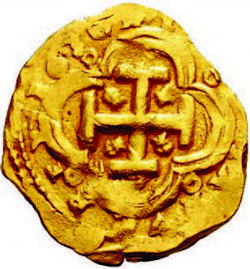 For comparison, a Seville media onza of 1676 is shown above. Note the semicircular loops of the tressure. Peninsular Jerusalem crosses vary considerably in size and shape but are never “holed”.
For comparison, a Seville media onza of 1676 is shown above. Note the semicircular loops of the tressure. Peninsular Jerusalem crosses vary considerably in size and shape but are never “holed”.
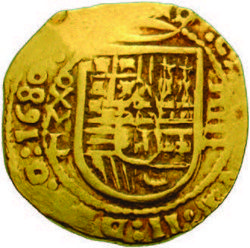
Mexico, 1680, four escudos (possibly an overdate?)
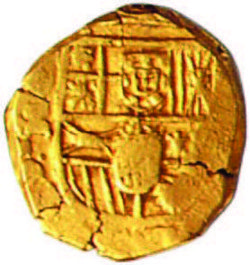 Seville, circa 1690, four escudos
Seville, circa 1690, four escudos
On the shield side of the new Mexican gold coinage, the central device is a crowned Hapsburg shield in a unique Mexican style that first emerged on the reales of Philip III and developed further on the coinage of Philip IIII. No escutcheon of Portugal is present, and the pomegranate of Granada, framed in a triangle, sits directly atop large cup-like enclosure holding the emblems of Flanders and Tyrol. On Spanish peninsular issues the device of Flanders and Tyrol is smaller, squarish, and sits lower on the shield, separated by at least 2mm from the shield of Portugal. Another obvious difference lies in the treatment of the fesse of Austria (left center of the shield). On Spanish peninsular issues, it is a single, thick, centered bar, often with thin lines radiating from its corners. On Mexican Jeweled Cross escudos it is represented by two thin horizontal lines.
The crown above the shield is also distinctive. The changing shape of Jeweled Cross crowns is of importance in providing some (sadly lacking) internal chronology for the series.
The Jeweled Cross One Escudo
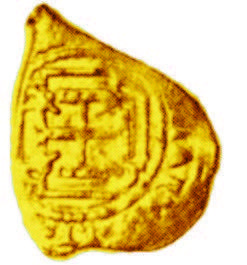
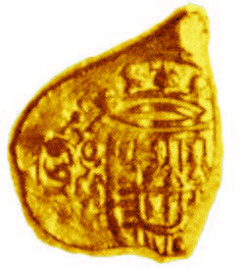
Mexico, Jeweled Cross one escudo, 1694 or 1695? (Tauler 93)
The smallest denomination of the Jeweled Cross series is the one escudo. It was struck continuously (as far as we know) from 1679 through 1695. Thereafter, the Jeweled Cross shows up on dated issues of 1697 and 1698, and it may well have continued in regular use throughout the 1695-99 period. The issue, as yet unresolved, is whether new Jeweled Cross dies were prepared after 1695 or only surplus Jeweled dies (produced before 1695) were re-used after 1695. Plain or “unjeweled” cross dies were introduced at Mexico City in 1695, presumably in all denominations, but as yet no Plain Cross one escudos are known from the period 1695-99. Dated Jeweled Cross one escudos are known for 1689, 1694*, 1697, and 1698 (four). The lone 1694 is pictured to the right. It is marked with an asterisk * because it is possible that its last digit is a 5, or a 5/4, not a 4. No opportunity to examine the coin in person has presented itself.
The cross on this design is 8mm wide and on well struck issues shows an average of 25 holes. The shield is 10 x 12mm. Jeweled Cross one escudos vary considerably in shape but roundish ones average about 17mm. Alan Craig gives the average weight of Fleet era Mexican one escudos as 3.37gm. No Jeweled Cross one escudo in the Gold Cobs Census weighs less than 3.38gms, which is the legally prescribed full weight. Besides the seven dated specimens noted above, seven undated or partially (169x) dated specimens, six of them recovered by the Real Eight Company, are known to the Gold Cobs Census. Several undated non-Fleet specimens are also known.
A 1679 Jeweled Cross One Escudo?
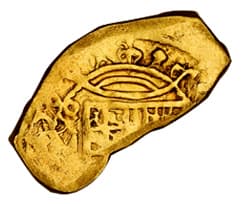
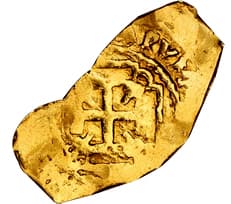
Mexico one escudo, (Tauler 92a)
The Mexico one escudo pictured above published in several texts as a possible 1679 issue, and it has come to auction under that description. It would be wonderful to have a sole survivor of the Christmas coinage of 1679, but there are reasons to be concerned about that attribution. Notice first the doubled upper loop of the base of the crown. This feature is not associated with any datable one or four escudos until 1694, with any two escudos until 1698, and with any onzas before 1691. No 1680s issues have it. It seems to be a stylistic feature that became established late in the Jeweled Cross series.
The width of a Mexico one escudo legend is typically 3mm. Measurement of the height of the last digit on the “1679” tells us that we are seeing only the bottom half of that digit, assuming it is normally placed. What we see in that bottom half is a small closed circular loop. Only the digits 6 or 8 have such a loop. The assumption that the last digit is normally placed could be challenged: perhaps we have a 9 punched in very low. This is possible, but the problem is that we see no trace of the tail of the 9 impinging on the border or the mint mark directly below. If we have a low 9, we should see tail!
The penultimate digit of the “1679” seems to be about 60% present, with the top of the digit sharply truncated.
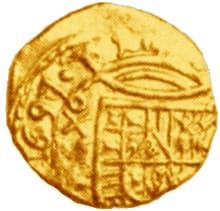
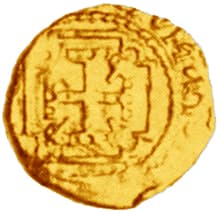
Mexico one escudo 1697 (Tauler 94)
Fortunately, we have a dated Mexico 1697 one escudo to give us some idea what a 7 looked like on a nearly contemporary Mexican issue. Judge for yourself. Notice the sharp straight lines of the down stroke and cross stroke on the 7. The strokes on the penultimate digit of the “1679”, by contrast, are noticeably curved and rounded.
Look at the 9 in the 1697 to the left. Imagine the top 40% of the digit cut off. That shape seems to be the shape we see on the “1679”. The penultimate digit on the “1679” is much more likely a truncated 9.
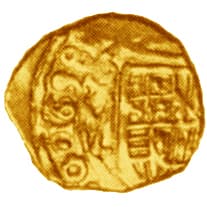

Mexico one escudo 1698 (Tauler 95)
The conclusion to which we are being lead is that the “1679” is in fact a 1698 (or 1696) issue. Thanks to the 1715 Fleet, we have five or six dated 1698 one escudo, including a specimen published as Tauler 95. Tauler 95 is pictured directly to the left. Too much critical detail has been lost on both the “1697” and Tauler 95 to permit a definitive die comparison, but several key features seem to have precisely the same shape and positioning. Notice that O above the M in the mint mark and the bottom half of the last digit (8) are positioned exactly the same on both coins. Notice also the irregular bent shape of the dividers in the castles and lions section of the shield. Tauler 92a seems to duplicate this distinctive die feature.
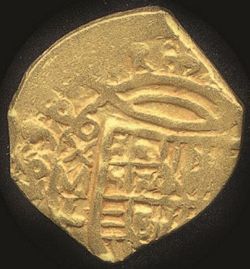 Finally, all these details are repeated even more clearly and conclusively on a 1698 in the FIorida Collection (#1367). The crown and shield and mint mark are identical in fine detail to those on the “1679”. The “1679” one escudo seems almost certainly to be an issue of 1698.
Finally, all these details are repeated even more clearly and conclusively on a 1698 in the FIorida Collection (#1367). The crown and shield and mint mark are identical in fine detail to those on the “1679”. The “1679” one escudo seems almost certainly to be an issue of 1698.
A Jeweled Cross One Escudo Royal?
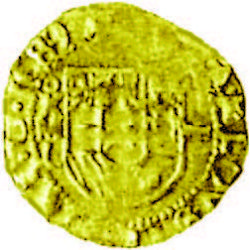
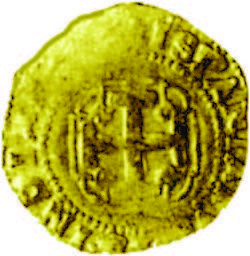
The Mexico one escudo pictured above has been published as a possible 1689 Royal or Redondo issue (Tauler 92). As such it would be the only Jeweled Cross Royal. No doubt Mexico City struck some Royals in the Jeweled Cross period. Unfortunately, this is not one of them. It is not a Royal, or even a failed attempt to strike a Royal (“near-Royals” as they are called). It is not even a product of the Mexico City mint. Look at the crude shield, which is a farrago of missing detail and incorrect detail. No shield like this ever came out of the Mexico City mint, especially on a Royal!
On the other side, the tressure and fleurs are also obviously wrong. Detail after detail condemns it.
We mention this coin to alert collectors. More than one example may exist and it does not seem to be published as a counterfeit. Its weight is unrecorded but it is 21mm in diameter. The average diameter of an early Mexico one escudo is 17mm, the largest authentic one escudo known is slightly under 19mm. (Special thanks to Mike Dunigan for information about this coin.)
The Jeweled Cross Two Escudos
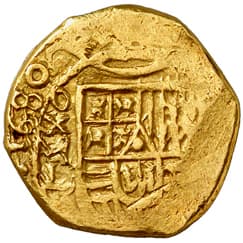
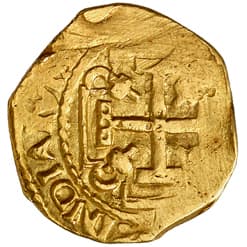
Mexico, 1680, two escudos (Tauler 192)
The second denomination in the Jeweled Cross series is the two escudos. It was struck continuously (as far as we know) from 1679 to 1695. Thereafter, the design is found on a single 1697 issue and on an overdate 1698/X issue. The 1697 and 1698 Jeweled escudos may have been struck from dies prepared in those years or possibly with surplus dies produced in 1695 or earlier. The Plain Cross design was introduced in 1695. Dated Jeweled Cross specimens are known for 1680 (two), 1681, 1691, 1692*, 1695, 1697 and 1698. The 1692 is marked with an asterisk * because that date is not certain. Tauler 194a, catalogued as a 1693 two escudos, has a 13mm cross and a 24mm planchet. It is a four escudos.
The cross on this denomination is 9mm wide and on well struck issues shows an average of 29 holes. The shield is 10.5 x 13mm. Jeweled Cross two escudos vary considerably in shape but roundish ones average about 20mm. Alan Craig gives the average weight of Fleet-era Mexican two escudos as 6.75gm. Jeweled Cross two escudo in the Gold Cobs Census weighs from 6.75 to 6.78gm.
As explained earlier, it is possible that the first Jeweled Cross dies were prepared before 1679. Certainly the 1679 dies were not retired after one week’s use in late December, though they may been redated for use in 1680. Two and four escudos dated 1680 should be studied for evidence of reworked dates.
Besides the eight dated specimens noted above, fourteen undated specimens,eleven of them recovered by the Real Eight company, are known to the Gold Cobs Census.
The Jeweled Cross Four Escudos
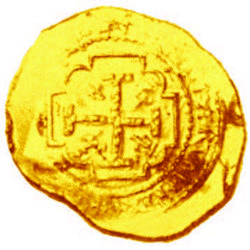
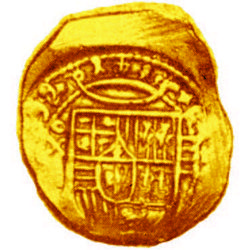
Mexico 1699/8/X four escudos (Tauler 86a)
Jeweled Cross four escudos were struck continuously (as far as we know) from 1679 to 1695. Thereafter, the design is known on a 1698 issue and on an overdate 1699/8/X issue, possibly from dies produced in 1695 or earlier. The Plain Cross design was introduced in 1695.
Dated Jeweled Cross specimens are known for 1680, 1693, 1694 (two), 1695 (three)*, 1698, and 1699/8/X (two). Some numismatists believe that Tauler 84, listed as one of the 1695s, may actually be a1696/5 issue. The 1693 four escudos is misclassified as a two escudos in Tauler’s Oro Macuquino. The cross on the four escudos is 13mm wide and shows an average of 32 holes (at least on well struck issues). The shield is 14 x 17mm.
Jeweled Cross four escudos vary in shape but roundish ones average about 25mm. Alan Craig gives the average weight of Fleet-era Mexican four escudos as 13.52gm. All Jeweled Cross four escudos in the Gold Cobs Census have weighed 13.60gm or more.
Besides the ten dated specimens noted above, nine undated specimens, four of them recovered by the Real Eight Company, are known to the Gold Cobs Census.
Did Mexico City strike a Plain Cross Four Escudos in 1693?
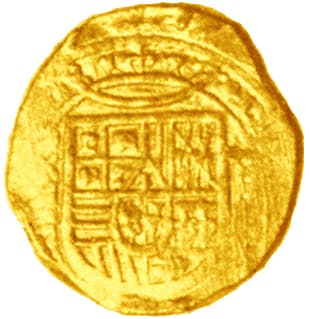
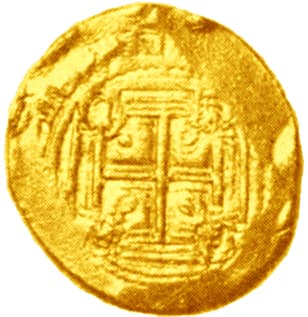
Mexico four escudos (Tauler 81)
The Real Eight Company believed they had found one and brought it to auction in November of 1972 as lot 38 in Schulman’s SPANISH GALLEON TREASURE (where it fetched an impressive $1,400). In oversize bold type the Schulman catalog described the coin pictured to the left as a “unique ½ doubloon of (169)3” and as such “the Earliest Dated Mexican Gold Coin in the 1715 Disaster.” The definitive catalog of the gold cob coinage, Oro Macuquino (2011), reports this information (Tauler 81).
An opportunity to re-examine the coin recently presented itself. The last digit of the date is somewhat hard to read—but clearly it is not a 3.
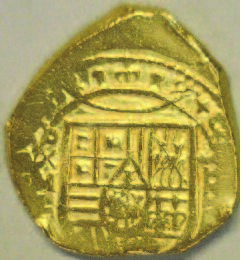 Fortunately, there are two other dated Plain Cross four escudos whose dies match the present coin and confirm its correct dating. To the left is a four escudos in a prominent Mexican collection. Through its date is truncated, we read the bottom of the 695.
Fortunately, there are two other dated Plain Cross four escudos whose dies match the present coin and confirm its correct dating. To the left is a four escudos in a prominent Mexican collection. Through its date is truncated, we read the bottom of the 695.
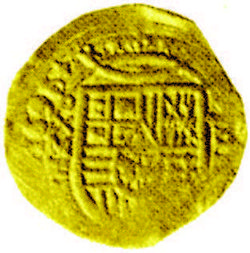 Another 1695 (Tauler 84) shows a full three digit date. Tauler reads this date as 1695, though it appears that the last digit may be an overdate, possibly a 6/5. In any case, Tauler 81 is not 1693 issue, but a media onza struck with a shield die cut in 1695 and perhaps reused in 1696. Plain Cross issues began in 1695, not 1693.
Another 1695 (Tauler 84) shows a full three digit date. Tauler reads this date as 1695, though it appears that the last digit may be an overdate, possibly a 6/5. In any case, Tauler 81 is not 1693 issue, but a media onza struck with a shield die cut in 1695 and perhaps reused in 1696. Plain Cross issues began in 1695, not 1693.
The Jeweled Cross Eight Escudos
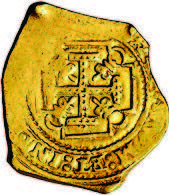
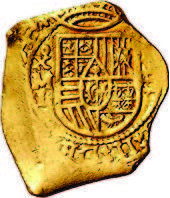
Mexico eight escudos (16)94/2
The Jeweled Cross eight escudos was likely struck from 1679 to 1695 without interruption. No dated example exists after 1695 but at least one onza with a Jeweled Cross pairs with a dated 1697/6 shield (Florida State Collection # 11.00230). Plain cross designs were introduced in 1695. Dated specimens are known for 1691(two), 1694/2, and 1695.
The cross on this design is 15.5mm wide and on well struck coins shows an average of 34 holes. The shield is 16 x 20mm. Jeweled Cross eight escudos vary in shape but roundish ones average a large 35-36mm. Alan Craig gives the average weight of Fleet-era Mexican eight escudos as 26.75gm. The Jeweled Cross eight escudos in the Gold Cobs Census range from 26.6 to 27.1gm.
Besides the four dated specimens noted above, nine undated specimens, three of them recovered by The Real Eight Company, are known to the Gold Cobs Census.
Barely Jeweled Escudos: the final Jeweled Cross Issues?
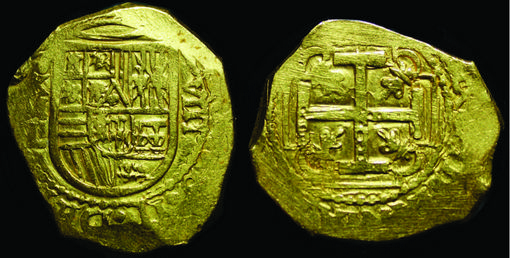
At first glance we might think the Jeweled Cross onza pictured above just has a worn cross die from which much detail has been lost. Not so. Careful examination of the cross side reveals that the die was in good condition. The reason why most of the holes in the cross are missing is that they were never punched into the die. And the ones that are present are ill spaced and badly mispunched. It is hard to count but perhaps 13 of the normal 34 holes are present. Was a very hung-over die sinker just having a bad day? Even on the one and two escudos Jeweled Cross issues there was usually care taken to fully “jewel” the cross.
A single issue like this by itself would need no further explanation, but it is now clear that there exists a group of these “barely jeweled” escudos in all denominations. None of these yet has offered a clear date to securely anchor the group, but by style they are 1690s issues, most like the 1694-95 issues. One possible explanation for this group is that as we approached the inauguration of the Plain Cross issues in 1695 it was no longer felt necessary to carefully and fully “jewel” the cross. The concerns that had mandated the selection of the very distinctive Mexican Jeweled Cross 20 years earlier may have no longer been felt. A second factor pushing for an ad hoc simplification of the dies could have the high mintage of 1694-95. In 1695 Mexico City minted nearly 300,000 pesos in gold, approximately six times the average mintages of the 1680s and early 1690s. Mexico City was no doubt pushed to produce enough dies to accommodate this ballooning coinage. If these barely jeweled cross dies were engraved at late notice in 1694 or early 1695, when completely plain crosses were about to go into production, there would have been no compelling reason for an over-busy die cutter to finish a jeweled cross in traditional detail. This view would have us regard these “barely jeweled” crosses as the last stage in a process of cross simplification that led to (or paralleled) the completely plain crosses first manufactured in 1695. This view is probably correct, but until we have a dated (or die matched) example of the barely jeweled coinage, it also remains possible that these coins were struck from dies produced 1696-99, simultaneously with fully jeweled and plain issues of that period. Purely stylistic factors do not compel us to date these coins to 1694-95.
When did the Jeweled Cross series end?
We do not know whether Jeweled Cross dies were manufactured after 1695, when Plain Cross dies were introduced. That Mexico City simultaneously produced jeweled, partially jeweled, and plain cross dies for five years would be unprecedented if the mint saw these as distinct series. The Jeweled Cross dies used on 1695-99 escudos could all be surplus dies from the big coinage of 1694-95, pressed back into service when current dies failed, but there are problems with this view. The years 1696-99 all saw a substantial gold coinage at the 200,000 peso per year level. If there were surplus 1695 dies, we would expect them to be used (and used up) in the first years of that period. But instead we see crisp two and four escudos fully jeweled dies coming into use with the 1698 and 1699 coinage. Moreover, most of the surviving Mexican escudos datable to 1695-99 are Jeweled Cross issues. Are we to believe that Mexico City struck most of its substantial gold coinage for four years with surplus dies?
A full account of the changes that took place in the Mexican gold coinage in the period 1695-1700 is a complicated business. It would be gratifying if we could say, unifying the complexities, that there is a general tendency to move toward a simpler design. Once the jewels are gone, the arms and crossbars of the cross tend to get thinner. Once the crossbar have become as thin as the tressure lines, it becomes simpler to connect crossbar and surrounding tressure into the rectangular boxes we are familiar with on the classical Box-End Cross issues of 1700-1710. The problem with this story is that changes just mentioned do not occur in 1695 or gradually over the 1695-99 period. They appear abruptly in 1700. The only change datable to 1695 is the appearance of the plain cross. Tressure, fleurs, and the shape of the cross remain the same until 1700. Below is the Plain Cross Royal of 1695. Notice how similar it is in all other features of the cross side to later Jeweled Cross issues. There is no hint of a classic Box-End Cross. Compare the 1695 Royal with the Box-End Royal of 1702. Notice how much has changed by 1702 in the cross and tressure and fleurs. These changes originate in 1700.
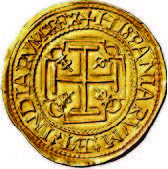
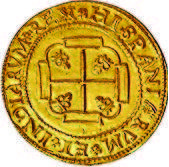
Mexico, 1695, eight escudos Royal Mexico, 1702, eight escudos Royal
The conclusion to which we are led is that Mexico City did not undertake a deliberate design change in 1695 (and was not aware it had affected one). The Plain Cross series of 1695-99 is explained by the fact that Mexico City acquired a set of new cross punches in 1695. On the new cross punches the arms and crossbars were too thin to “jewel”. The older thicker cross punches were not yet exhausted and continued to be used as well. Probably as late as 1699 thick and thin cross punches were both still being used to prepare gold dies. Some thick crosses were jeweled in traditional fashion and some only in a token partial fashion (as production schedules allowed). The Mexico City talladors did this without thinking they were simultaneously producing two or three different styles of coinage. Finally, in 1700 a deliberate design change did occur with the Box-End Cross replacing forever the Jeweled and Plain Crosses.
Some Observations on Collecting the Jeweled Cross Series
The rarity of this series was first noted in the pre-Fleet monographs of Lopez-Chavez Y Sanchez (1961-63). Since 1963 salvages of the 1715 Fleet have contributed new coins to the point where perhaps 80-90% of the Jeweled Cross coinage now comes from the Fleet. Unfortunately, that source now seems exhausted. Only a few Jeweled Cross escudos have come to Division in the last 30 years. We are left with a very small coinage to study and collect: four dated Jeweled Cross onzas are known to our census, eight media onzas, and eight two escudos. In all, 27 dated Jeweled Cross escudos anchor the entire series spanning 21 years. (Six of these coins are impounded in state collections and permanently unavailable to collectors.)
A significant infusion of new Jeweled Cross coinage would be very welcome. Alas, nothing is on the horizon. A Mexican aviso lost while carrying payroll in the early 1690s is known but lies in a National Park. No commercial salvage of that vessel or a similar “lost” 1715 ship seems possible. The Vigo Bay wrecks of the 1702 Fleet have now been put off limits to salvage by the Spanish government. Several promising wrecks lie in the territorial waters of other governments that are now adamantly opposed to any commercial salvage of Spanish Colonial wrecks. There the matter rests for now.
Without the time capsules that shipwrecks provide, the survival of low mintage gold issues becomes quite problematic. If Pradeau’s numbers are correct, a typical 1680s gold mintage was 50,000 pesos. From the entire period of 1679-1690 it could be that just four dated Jeweled Cross escudos and 6-8 undated coins survive. Compute the survival rate if you like tiny fractions. Gold production at Mexico City spiked in 1694-1695. 299,200 pesos, four times that of the average 1680s mintage, were struck in 1695. Thanks to the 1715 Fleet, we now have a grand total of eight dated Jeweled Cross specimens from 1694-95 (and possibly a dozen more undated escudos). Not big populations!
From the perspective of having a decent supply for interested collectors, the surviving population of Jeweled Cross escudos remains disheartening small. As a comparison, consider the surviving population of 1714 Mexican two escudos. There are hundreds more 1714 two escudos than all the denominations of Jeweled Cross escudos combined. Likewise, there are more 1714 Mexican onzas than all Jeweled Cross denominations combined. The point is, unless we get lucky with an unexpected wreck or hoard, collectors and students of the first series of Mexican gold must be very patient people.
Appendix: Dated Jeweled Cross Escudos known to the Gold Cobs Census (Oct. 2012)
The Gold Cobs Census, now more than 20 years old and going strong, is an attempt to record the surviving Spanish Colonial escudos held privately and in public collections. For a rare series like the Jeweled Cross issues of 1679-1699, this is a practical undertaking because the numbers are small. Our coverage of gold cobs at auction in the last 50 years is reasonably comprehensive. Division reports from the State of Florida record over 6,500 gold cobs reported to the state by 1715 Fleet salvors since 1963. Private salvage reports from The Real Eight Company and other groups supplement the state reports. The late Lou Ullian was of great assistance is refining and confirming Fleet coin populations. No doubt some important escudos remain uncounted, but the infrequency with which we now add new coins to the census suggests that our count is not far off the mark.
| Date | 1 escudo | 2 escudos | 4 escudos | 8 escudos |
| 1679 | ||||
| 1680 | 2 | 1 | ||
| 1681 | 1 | |||
| 1682 | ||||
| 1683 | ||||
| 1684 | ||||
| 1685 | ||||
| 1686 | ||||
| 1687 | ||||
| 1688 | ||||
| 1689 | 1 | |||
| 1690 | ||||
| 1691 | 1 | 2* | ||
| 1692 | 1* | |||
| 1693 | 1 | |||
| 1694 | 1* | 2 | 1 (4/2 overdate) | |
| 1695 | 1 | 2 | 1 | |
| 1696 | ||||
| 1697 | 1 | 1 | ||
| 1698 | 4 | 3 | 1 | |
| 1699 | 1 (9/8/X overdate) | |||
| 1700 | ||||
| Totals | 7 | 10 | 8 | 4 |
Issues marked * are unconfirmed. At least one 1691 onza seem likely to be confirmed.
Except where specified, all coin images are courtesy of Rafael Tauler Fesser, whose magnificent on-line archive Escudos Macuquinos Imperio Espanol supplements his definitive print volume Oro Macuquino: Catalogo Imperio Espanol 1474 a 1756 (2011).
